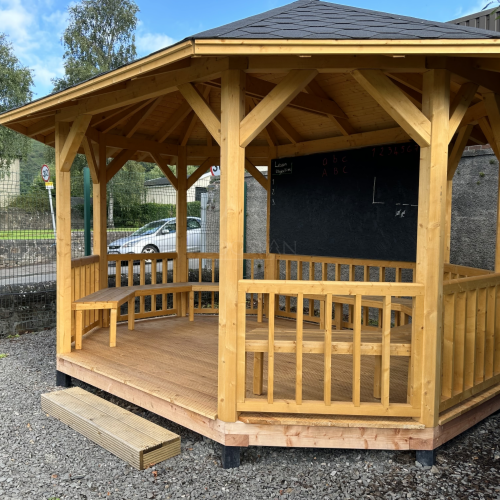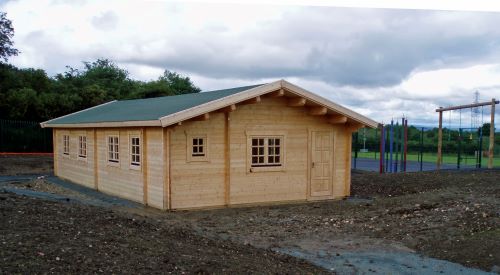Did you know that studies have shown that students learn better in outdoor classrooms? There are many reasons for this, but one of the most important is that it allows students to connect with nature. When children can see and interact with the natural world around them, they are more likely to be interested in learning about it. In this blog post, we will discuss the benefits of a outdoor classroom and how they can enhance the learning experience for students!
1. Increases Engagement and Motivation:
Learning outside of the traditional classroom setting can offer many advantages for students. Outdoor classrooms provide an exciting and stimulating environment that encourages curiosity, enthusiasm, and engagement in the subject. Research has proven that students in outdoor learning environments have increased motivation and increased mental well-being due to interaction with nature. Additionally, time spent outside can be extremely beneficial to physical and psychological health by reducing stress levels, improving cognitive development, and strengthening on-task behaviors. Hence, outdoor classrooms can be a powerful teaching tool and an essential part of promoting health and balanced development for today’s youth.
2. Improves Attention Span:
It’s no surprise to hear that the great outdoors can be beneficial for students when it comes to their studies. The most recent research indicates that outdoor learning environments can considerably improve students’ attention spans and help them better focus on their tasks at hand. Being in nature offers a natural respite from distractions, allowing them to really hone in and remain focused on the subject of study. This grown-up version of ‘taking a break outdoors’ also entails being able to tailor the environment to specific lesson plans and curricula, which not only makes teaching easier but allows teachers to gain -and keep- their student’s attention. Outing traditionally held lessons outside then proves to be an instinctive and highly effective way of building knowledge and attitude for both teachers and students alike.
3. Increased Creativity:
Students learning in an outdoor classroom are also more likely to be creative and think outside the box. Nature is a great source of inspiration and can help spark new ideas and perspectives. This creativity can then be applied to any subject matter, from mathematics to literature. Additionally, being in nature often encourages student teamwork and collaboration, which fosters creativity. By allowing students to work together and share ideas, outdoor classrooms create a unique learning environment that can lead to more meaningful learning experiences.
4. Encourages Active Learning:
Outdoor classrooms encourage active learning, which benefits physical and mental health. Being outdoors allows students to move around and be physically active while learning. This can help keep them alert and engaged in the subject material while also providing additional exercise that improves overall health and well-being. Additionally, active learning can help increase the amount of information retained as students engage in multiple ways with the material.
5. Promotes Sustainability:
Perhaps one of the most important benefits of outdoor classrooms is that they promote sustainability. By teaching students to be aware of their environment and take steps to protect it, encourages them to be environmental-conscious citizens later in life. Outdoor classrooms also provide an ideal opportunity for students to practice sustainable habits firsthand. From composting to harvesting natural resources, outdoor learning initiatives give students a chance to engage in hands-on activities while learning about environmental responsibility.
6. Improved Connections:
Outdoor classrooms can also help students develop better connections with their peers. By being in an outdoor environment, students are able to interact more freely and develop relationships with those around them. This is especially important for younger students who may struggle to make friends or form connections on their own. Outdoor learning initiatives provide a safe space for them to engage in meaningful conversations and build trusting relationships with their peers.
7. Increased Confidence:
Outdoor classrooms can also help students build confidence. Engaging in activities outdoors provides ample opportunity for exploration and growth. This helps children develop a sense of ownership over the material being studied and equips them with the skills necessary to tackle more complex tasks. This can lead to increased self-confidence and a greater sense of accomplishment.
8. Improved Mental Health:
Outdoor classrooms are a great way to provide students and teachers with an alternative learning environment. Being in nature can help reduce stress and anxiety levels that tend to build up in traditional classrooms. This kind of escape not only refreshes the mind but also allows students to interact with their environment on a much deeper level. Learning outside encourages appreciation and engagement with nature, resulting in increased positive mental health for those involved. In addition to physical outdoor activities, outdoor classrooms have proven long-term benefits in mental health and well-being, making them a powerful educational tool for teachers and students alike.
9. Enhances Your Education:
Outdoor classrooms provide a unique and dynamic learning environment that can help improve the overall quality of education. By providing an immersive experience in nature, teachers can facilitate learning excitingly and engagingly. Students can develop new skills and explore their interests with the various activities available. This type of learning is enjoyable and encourages students to think independently and take ownership of their education.
10. Better Retention Of Information:
One of the most important benefits of outdoor classrooms is that they can help students retain more information. Traditional teaching methods tend to restrict student engagement, resulting in students struggling to remember what they’ve learned. Learning outside encourages active participation by utilizing multiple senses and engaging students deeper. This helps to increase the amount of information retained, resulting in a better understanding of the material.
Conclusion:
Outdoor classrooms are becoming increasingly popular due to their many benefits. By providing students with a stimulating and immersive learning environment, these initiatives help improve both academic performance and mental health. From improved connections to increased confidence and better retention of information, teachers and students alike can take advantage of the many advantages that outdoor classrooms offer.









